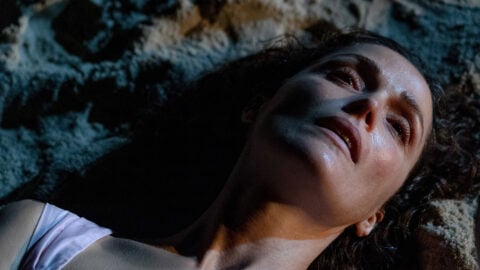Review: One Day Pina Asked...
One Day Pina Asked… has an exclusive theatrical engagement at Film Society of Lincoln Center from June 6 – 12.
One Day Pina Asked…
During a 2011 post-screening Q&A of Ishtar at the 92nd Street Y, Elaine May quipped, “Some people say it was too ahead of its time. ‘Ahead of its time’? How is that even possible!?” May’s point: the tag is nothing more than a glib sidestep, because everything is inescapably of its time, no matter how progressive. This reality comes into sharpest focus when looking at members of the avant-garde, and how they reflect and play off of each other. Chantal Akerman’s One Day Pina Asked…, shot over several months in 1982, is one such document, a quiet, distinctive portrait of Pina Bausch’s Wuppertal Dance Theater.
Already pillars of their mediums, both Chantal Akerman and Pina Bausch were considered revolutionary for overlaying larger conceptual frameworks onto autobiographical and/or shared quotidian female experience. Jeanne Dielman, 23 Quai du Commerce (75) is as much a work of choreography as Bausch’s pieces are, in Akerman’s words, “little films to which she adds dance.” Their respective turns toward the personal are equally thanks to Sixties feminism, American and pan-European influences, and belonging to the first post-WWII generation.
Come Dance With Me
Like Akerman in Dis-moi (80) or her 2007 installation based on her Jewish grandmother’s diaries, “Walking Next to One's Shoelaces into an Empty Fridge,” Bausch in part sought to regain what had been lost in the war. Trained in German Expressionist Dance (Ausdruckstanz)—which, along with all arms of German Expressionism, had its development prematurely halted by a Nazi ban—Bausch continued its project by putting emotional states and dramatic elements at the heart of her choreography, as well as choral elements introduced by the style’s founder Rudolf von Laban. In Bausch’s 1980 (80), featured in Akerman’s film, a chorus of dancers, dressed in fine evening wear, move together with small gestures: both men and women gingerly apply makeup from an imaginary hand compact. In Kontakthof (78), the group swarms en masse around a single female dancer, their individuality expressed through the little twists they give to their cruelty—pulling her up off the floor against her will, positioning her, aggressively groping her body and hair, or booping her nose.
The gestures are echoed in backstage footage of the dancers between numbers, applying makeup or hurriedly pulling on their costume. As Akerman notes in her voiceover at the start of the film (which abruptly disappears, only to return 40 minutes later), Bausch incorporated the personal experiences of her dancers. During interviews with the (trilingual!) troupe, one describes what happened when Bausch arrived at rehearsal and asked them what came to mind when they heard the word “love,” eliciting a range of culturally specific responses. (There’s also a comical sequence in which the dancers, running around in circles, shout three stereotypes about their respective homelands into a microphone.) Second only to the tantalizingly short interview with Bausch herself at the end of the film, the interview that lingers longest in my memory is of a young German dancer who performed an American Sign Language version of George Gershwin’s “The Man I Love.” (As he explains, he learned it while on vacation in the United States, and, because Bausch asked her dancers to tell her something they were proud of during rehersals, it was eventually incorporated into Carnations [1982].) His performance of the song through sign language is no less controlled and emotive than his dancing. Sophie Tucker’s histrionic vocals, played on a scratchy record, are juxtaposed with his signing and his monotone voicing of the lyrics in time with hers: “And. So. I’m. Waiting. For…The. Man. I. Love.”
Carnations
When we see him perform the song later in front of a large live audience, they laugh—alienation, another key component of Ausdruckstanz, Tanztheater, or any other number of dramaturgical styles, is often used for humor. Yet like all expertly deployed alienation, there’s something heartbreaking about his first performance in rehearsal, something that is somehow lost when im theater. While Wim Wenders’s 3-D Pina may be the crowd-pleasing, pumped-up version of Bausch’s dances, Akerman’s vision is far more intimate and emotive. True to both her and Bausch’s vision, One Day Pina Asked… is less an attempt at archival documentation than at expressing a feeling through movement and moment.







